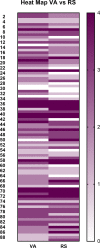Evaluating the validity and reliability of a visual dental scale for detection of periodontal disease (PD) in non-anesthetized dogs (Canis familiaris)
- PMID: 30256813
- PMCID: PMC6157863
- DOI: 10.1371/journal.pone.0203930
Evaluating the validity and reliability of a visual dental scale for detection of periodontal disease (PD) in non-anesthetized dogs (Canis familiaris)
Abstract
Periodontal disease is one of the most common conditions affecting companion dogs. The objectives of this cross-sectional study were: to determine 1) the agreement between visual assessments (VA) of periodontal disease (PD) performed on awake dogs and the reference standard (RS) of a dental examination and radiographs performed with the dog under general anesthesia, and 2) inter-rater reliability (IRR) for two individuals performing VAs of PD on the same dogs. One hundred and eight dogs were recruited from three veterinary practices. An oral examination and visual PD staging based on the American Veterinary Dental College's (AVDC) 5-point scale was performed by the investigators prior to general anesthesia and the dental procedure. After the anesthetic evaluation and radiographs, the attending veterinarian staged each dog based on the AVDC's 5-point scale. Agreement between the VA and RS as well as IRR were determined using percent agreement and a weighted kappa statistic. Eighty-nine dogs received a complete oral examination under general anesthesia with periodontal probing and full-mouth radiographs. Fifty-nine dogs received a VA by both raters. VA agreed with the RS 41.57% of the time with a weighted kappa of 0.42 (95% confidence interval 0.29-0.55), indicating moderate agreement. Between raters, VA agreed 61.02% of the time with a weighted kappa of 0.63 (95% confidence interval 0.49-0.76), indicating substantial IRR. The results of this study reinforce the idea that an oral examination in an awake dog can be a helpful screening tool, but should not be considered a comprehensive evaluation of periodontal health. In facilities housing large numbers of dogs such as shelters, breeding kennels, and research facilities, use of a VA can aid in identifying and prioritizing dogs most in need of procedures such as professional cleaning, periodontal treatment, including closed root planing, or surgical care.
Conflict of interest statement
Funding was provided by commercial sources, the Pet Food Institute and World Pet Association. Additionally, MedVet provided support in the form of salary for author Matthew Lemmons. The funding sources did not have any involvement in the design or conduct of the study; collection, analysis, or interpretation of the data; writing or approval of the manuscript; or decision to submit the manuscript for publication. This does not alter our adherence to PLOS ONE policies on sharing data and materials.
Figures
Similar articles
-
A cross-sectional study to estimate prevalence of periodontal disease in a population of dogs (Canis familiaris) in commercial breeding facilities in Indiana and Illinois.PLoS One. 2018 Jan 18;13(1):e0191395. doi: 10.1371/journal.pone.0191395. eCollection 2018. PLoS One. 2018. PMID: 29346448 Free PMC article.
-
Oral-Fluid Thiol-Detection Test Identifies Underlying Active Periodontal Disease Not Detected by the Visual Awake Examination.J Am Anim Hosp Assoc. 2018 May/Jun;54(3):132-137. doi: 10.5326/JAAHA-MS-6607. Epub 2018 Mar 20. J Am Anim Hosp Assoc. 2018. PMID: 29558213
-
Day one core competencies in veterinary dentistry.J Am Vet Med Assoc. 2023 Aug 9;261(12):1880-1886. doi: 10.2460/javma.23.05.0242. Print 2023 Dec 1. J Am Vet Med Assoc. 2023. PMID: 37562779
-
How to obtain and interpret periodontal radiographs in dogs.Clin Tech Small Anim Pract. 2000 Nov;15(4):204-10. doi: 10.1053/svms.2000.21042. Clin Tech Small Anim Pract. 2000. PMID: 11269995 Review.
-
Problems associated with veterinary dental radiography.Probl Vet Med. 1990 Mar;2(1):46-84. Probl Vet Med. 1990. PMID: 2134590 Review.
Cited by
-
Periodontal disease is associated with cognitive dysfunction in aging dogs: A blinded prospective comparison of visual periodontal and cognitive questionnaire scores.Open Vet J. 2021 Apr-Jun;11(2):210-216. doi: 10.5455/OVJ.2021.v11.i2.4. Epub 2021 Apr 19. Open Vet J. 2021. PMID: 34307077 Free PMC article.
-
Effect of age on dental plaque deposition and its control by ultrasonic scaling, dental hygiene chew, and chlorhexidine (0.2%w/v) in dogs.Vet World. 2019 Nov;12(11):1872-1876. doi: 10.14202/vetworld.2019.1872-1876. Epub 2019 Nov 28. Vet World. 2019. PMID: 32009769 Free PMC article.
-
A Comparison of the Oral Microbiota in Healthy Dogs and Dogs with Oral Tumors.Animals (Basel). 2023 Nov 21;13(23):3594. doi: 10.3390/ani13233594. Animals (Basel). 2023. PMID: 38066947 Free PMC article.
-
Clinical health markers in dogs fed raw meat-based or commercial extruded kibble diets.J Anim Sci. 2021 Jun 1;99(6):skab133. doi: 10.1093/jas/skab133. J Anim Sci. 2021. PMID: 33939804 Free PMC article.
-
Effects of Periodontal Therapy on Blood Lipid Levels in 10 Dogs With Periodontitis and Hyperlipidemia.Case Rep Vet Med. 2025 Jun 16;2025:9088922. doi: 10.1155/crve/9088922. eCollection 2025. Case Rep Vet Med. 2025. PMID: 40552326 Free PMC article.
References
-
- Wiggs RB, Lobprise HB. Periodontology In: Wiggs RB, Lobprise HB, editors. Veterinary dentistry, principles and practice. Philadelphia: Lippincott Raven; 1997. pp.186–231.
-
- Hamp SE. Prevalence of periodontal disease in dogs. J Dent Res. 1975;54(1): L5.
-
- Lund EM, Armstrong PJ, Kirk CA, Kolar LM, Klausner JS. Health status and population characteristics of dogs and cats examined at private veterinary practices in the United States. J Am Vet Med Assoc. 1999;214(9): 1336–1341. - PubMed
-
- Diez M, Picavet P, Ricci R, Dequenne M, Renard M, Bongartz A, et al. Health screening to identify opportunities to improve preventive medicine in cats and dogs. J Small Animal Prac. 2015;56(7): 463–469. - PubMed
Publication types
MeSH terms
LinkOut - more resources
Full Text Sources
Other Literature Sources



